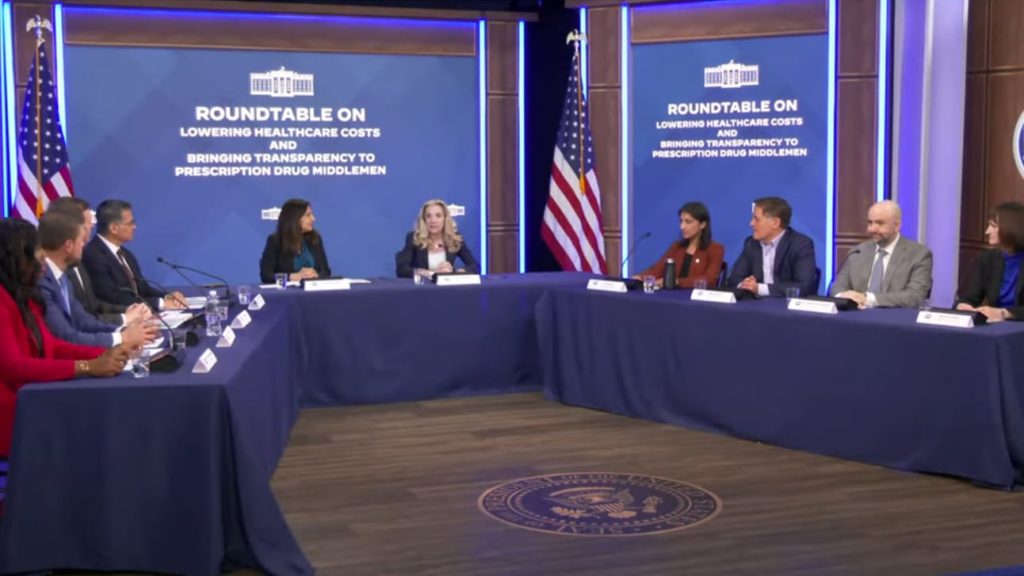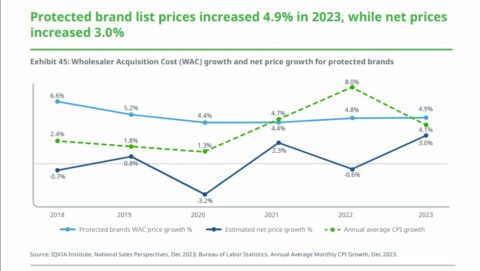There were three big takeaways from yesterday’s White House “listening session” on PBMs:
The White House wants the David vs Goliath narrative. Of the five non-government speakers, four represented pharmacies. The other was from Blue Shield of California. The overwhelming impression was one of the embattled independent pharmacist getting rolled by monopolistic and ruthless big PBMs. There was none of the PBM vs pharma debate that the PBMs seem to want (per the PCMA release on the gathering).
Mark Cuban is the face of the movement. The dude can communicate. He has a knack for the soundbite (he told attendees, to nervous titters, that PBMs were “shitting on independent pharmacies”). And he knows where the soft underbelly of the PBM industry is: the employers.
The White House doesn’t have a real plan. There wasn’t a lot of talk about specific initiatives, and HHS Secretary Becerra made it almost the entire way through his speech before even mentioning PBMs. (I get the need for “message discipline,” but Becerra spent most of his allotted time praising the IRA, which just felt out of sync.) I don’t doubt that the FTC has an approach, but the rest of the administration? Eh.
(You can watch the whole thing here. It’s an hour long. There’s also coverage from Endpoints, STAT, etc.)
This Health Affairs piece ought to be required reading. I’m not sure that the conclusion — that formulary exclusions and utilization management in Medicare drug coverage is through the roof over the past decade to so — is particularly surprising. Still, it’s important to have the receipts … and a baseline.
There are a couple of ways of looking at the data. One is retrospectively, seeing how access has eroded over the years, even as premiums and cost-sharing have risen. It is the story of the 2010s: “Plans are charging more and they’re covering less, so it’s a double whammy,” as study author Karen Van Nuys from USC put it in the USC press release.
The other way is as a predictor of future behavior. It’s clear that health plans and PBMs have figured out how to twist dials to maximize profits by complicating access for patients. Now, the 2010s — the study period — were a fairly stable time, policy-wise.
The question is what’s going to happen as Part D redesign kicks in and health plans are really put under the gun? It’s not particularly daring to prophesize that this trend, so well documented in Health Affairs, is only going to explode going forward.
The only questions are how big the explosion will be and whether the government is going to do anything about it. .
Damn, this is a good piece in Biospace that looks at the hints Pfizer dropped about how the IRA is influencing its move into cancer, where the portfolio will be weighted to biologics, not small molecules. None of this stuff is monogenic, to abuse a term … there are a lot of factors that go into this kind of decision-making. But it sure sounds like the IRA is providing some tailwinds as Pfizer tacks toward oncology.
This whole Dan Leonard op-ed in Law360 about the absurd and misdirected state and local lawsuits over insulin is worth a read (sorry about the paywall), but my favorite part is where Dan exposes a fundamental paradox: “the cities and states that are now filing suit are the same large employers that contracted with the PBMs to manage the drug benefits on behalf of their employees. These same contracts that cities and states entered into with the PBMs perpetuated the broken system we have today.” The call is coming from inside the house.
Opill, the first OTC birth control pill, will run $19.99 a month. Is that the right price? It’s hard to tell. KFF polling suggests that half of women can’t pay more than $10 a month for contraception. On the flip side, $19.99 is close to what other OTC meds cost — it’s about what Target is selling a month’s worth of Claritin for. Of note, prescription contraception is available with no cost-sharing under the ACA, but that doesn’t extent to OTC versions.
In response to the AstraZeneca IRA verdict, the government told all the other judges in all of the other IRA cases about their big win, which is not a surprise. What’s noteworthy is that Merck quicky hit back, filing a brief in its case distinguishing its arguments from those AstraZeneca made.
Politico said that Part D premiums are likely to spike right before the November election because of IRA-related reasons, which feels like a true and uncontroversial statement. The outlet also said that Republicans likely wouldn’t make that an issue, which feels … less true and uncontroversial.
If this email was forwarded to you, and you’d like to become a reader, click here to see back issues of Cost Curve and subscribe to the newsletter.





